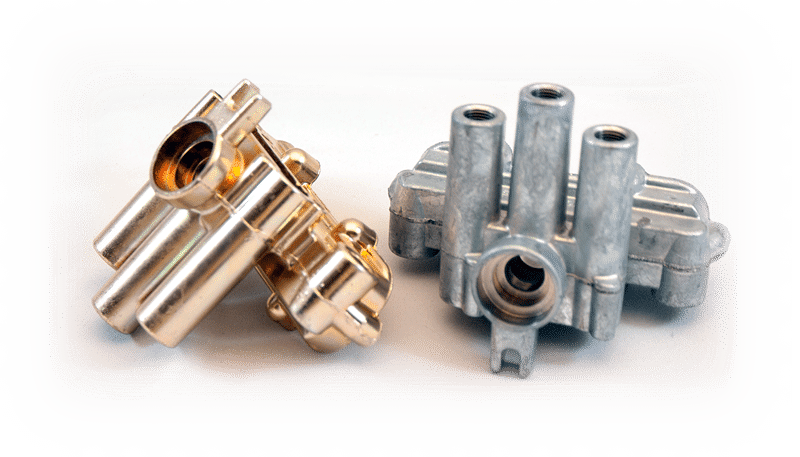In the sphere of metal manufacturing and fabrication, the fusion of 3D printing technologies has brought forth a notable revolution. Among the array of options, Acrylonitrile butadiene styrene (ABS) filament has emerged as a prevalent choice, owing to its cost-efficiency and adaptable nature. Nevertheless, a recurring issue persists with ABS 3D printed components, manifesting in a distinct matte texture along with discernible layer lines, necessitating the exploration of supplementary post-processing methodologies. Achieve flawless finishes with ABS acetone smoothing. Expert techniques and materials for superior results.
In the pursuit of achieving impeccable finishes akin to injection-moulded counterparts, ABS acetone smoothing emerges as a leading solution. This process involves utilizing acetone vapours to refine the surface of 3D printed ABS parts, eradicating layer lines and imperfections, and yielding a glossy, professional appearance.

What Is ABS Acetone Smoothing?
Understanding Acetone
Acetone, a transparent organic liquid renowned for its versatile solvent properties, acts as the key agent in ABS acetone smoothing. Its unique capability to dissolve both polar and nonpolar substances makes it unparalleled in the realm of solvents. This property arises from acetone’s chemical composition, combining polar and nonpolar elements, which contributes to its wide-ranging applications across diverse industries.
Interplay of Acetone with ABS Plastic
Acrylonitrile butadiene styrene (ABS), a thermoplastic polymer, displays intriguing interactions with acetone owing to its solubility in various compounds. When exposed to acetone, ABS undergoes a near-dissolution process, causing individual print layers to merge, resulting in a surface transformation from matte to glossy.
Why Should You Opt for ABS Acetone Smoothing?
Aesthetic Enhancement
ABS acetone smoothing delivers a superior gloss finish, obliterating unsightly layer lines and imparting a professional sheen. This enhancement is particularly appealing for models, figurines, and decorative pieces, eliminating the need for additional painting.
Eradication of Imperfections
Visible layer lines, a common occurrence in 3D printing, become a thing of the past through acetone smoothing. The process smoothens the surface, seamlessly merging the gaps between layers and reducing leakage, making ABS parts suitable for items like vases and containers.
Strengthening Properties
Beyond aesthetics, acetone smoothing contributes to strengthening ABS parts by promoting better interlayer adhesion, reducing stress points, and mitigating anisotropic mechanical properties inherent in FDM 3D printing.
Materials and Equipment Required for ABS Acetone Smoothing
For those dedicated to pursuing acetone smoothing, the utilization of readily available household items proves advantageous. Here’s an essential rundown of what you’ll need:
Varieties of Acetone
When opting for acetone to smoothen ABS, the selection of high-purity acetone is fundamental. It’s recommended to use acetone boasting a purity of 99% or higher. This purity standard ensures the absence of impurities, water, or other contaminants that could compromise the smoothing process or the quality of ABS plastic prints. Even minute impurities or moisture within the solvent can lead to irregular outcomes or potential damage to your 3D prints.
Safety Gear
Safety is paramount during ABS smoothing, considering the involvement of potentially hazardous chemicals. Ensuring adequate protective gear is imperative. Here’s a comprehensive list of safety equipment to prioritize when performing ABS acetone smoothing:
- Safety Glasses or Goggles: Shield your eyes against accidental splashes or fumes by wearing safety glasses or goggles featuring side shields.
- Respirator or Mask: Prevent inhalation of acetone fumes, particularly in poorly ventilated areas, by utilizing a respirator or mask equipped with organic vapor cartridges. Ensure it provides substantial protection against chemical fumes.
- Chemical-Resistant Gloves: Employ gloves made of nitrile or neoprene to protect your hands from direct contact with acetone. These gloves are specially designed to withstand chemical exposure.
- Long-Sleeved Clothing: Minimize skin exposure by wearing long-sleeved attire, a measure to prevent inadvertent contact with acetone.
- Ventilation: Conduct ABS smoothing in a well-ventilated area or resort to a fume hood if accessible. Adequate airflow aids in dispersing acetone fumes, reducing the risk of inhaling harmful vapours.
- Fire Extinguisher: Have a fire extinguisher in close proximity, given acetone’s flammability, to ensure a swift and safe response in the event of a fire.
- Safety Shower and Eye Wash Station: If available, acquaint yourself with the locations of emergency safety equipment such as safety showers and eye wash stations, vital in case of accidental acetone exposure.
Essential Tools
The following tools are indispensable for the process:
- Transparent Container: Select a container accommodating the size of your 3D-printed part. Transparent materials are preferable for monitoring the smoothing process. An airtight lid is optimal; alternatively, use a sturdy base or plate to create a sufficient seal, containing the acetone vapor effectively.
- Brush: Employ a brush for even application of acetone across the surface of your ABS print. It aids in spreading the solvent evenly, ensuring consistent smoothing.
- Aluminium Foil: Utilize aluminium foil as a base within the container to isolate the ABS part from the bottom, as acetone does not dissolve metals.
- Paper Towels: Essential for facilitating vaporization, soak these materials in acetone. Any absorbent paper towels or tissues suffice for this purpose.

Four-Step Guide to ABS Acetone Smoothing
In this section, we will detail the process of acetone smoothing into four comprehensive steps.
Step 1: Preparing the ABS Part
Commence the process with a clean and dry ABS printed part. Utilize dedicated plastic cleanup files (flat or half-round) to smooth the surface. This aids in eliminating aggressive points and layers that acetone cannot address. Avoid using files employed for other materials to prevent foreign particles from affecting the finish. While the filing process need not be overly time-consuming, neglecting this step may lead to uneven areas on your print.
Step 2: Applying Acetone
Let’s delve into the two most effective methods for smoothing ABS with acetone in a controlled manner:
Method 1: Brushing
This method involves using a brush to apply liquid acetone for a fairly smooth finish. Here’s a detailed process:
- Place a small quantity of liquid acetone in a shallow container.
- Dip the brush into the acetone solution and thinly spread it over the surface of the 3D-printed part.
- Continue application until satisfied with the level of smoothness and appearance.
- Allow the parts to dry after acetone application.
- While this method offers precision and is time-efficient, it may consume a substantial amount of acetone and sometimes result in uneven smoothing or streaks.
Method 2: Acetone Vapor Bath
This method involves exposing the ABS part to acetone fumes. Here’s a step-by-step guide:
- Make a Smoothing Box: Use a partially enclosed container to contain acetone fumes around the printed part.
- Put a Raised Platform inside the Box: Use a non-soluble platform to prevent direct contact of ABS parts with the bottom of the container.
- Use Paper Towels: Soak tissues or paper towels in acetone and place them along the edges of the container.
- Close the Smoothing Box: Create a few small holes in the lid to allow acetone fumes while preventing dangerous pressure buildup.
- Let the Smoothing Take Place: Monitor the process through the transparent box and remove the lid once the desired smoothness is achieved.
Step 3: Monitoring and Controlling the Process
Monitoring and controlling the acetone smoothing process, especially with vapor, is crucial. Set a timer and monitor the process through the transparent container to avoid over-smoothing.
Consider adding mild heat or a small fan inside the container for enhanced efficacy, but exercise caution with electronics to prevent potential hazards.
Step 4: Finishing Touches
Conclude the process by carefully removing the container in a well-ventilated area to prevent contact between paper towels and the 3D-printed part.
Avoid touching the semi-liquid part to prevent distortion, allowing excess acetone to evaporate and the piece to dry.
Inspect for a glossy finish. Sand for a matte finish or repeat the smoothing process if necessary. For painting, leave the part on a wire hanger for ease during the process.
For any holes created by the hanger, fill them if necessary, or leave them in less noticeable areas if painting. Finish by sanding, priming, and painting as desired for a refined final product.
Safety Precautions and Workspace Setup
Setting up your workspace is crucial to ensure your safety during the process. Implementing proper safety measures helps prevent unwanted hazards. Consider the following guidelines:
- Utilize Adequate Ventilation: During the acetone vapor bath process for your ABS print, expect a notable presence of acetone vapor. It’s imperative to handle acetone in a well-ventilated area to minimize inhalation risks.
- Wear Protective Gear: Always wear protective gloves and goggles when handling acetone. While acetone isn’t highly toxic, these precautions significantly reduce potential exposure risks and protect yourself.
- Select Quality ABS Filaments: Invest in high-quality ABS filaments from reputable brands. Inexpensive filaments might contain additives from various plastics that may not respond favourably to acetone. Choosing trusted ABS filaments ensures optimal results and safeguards your efforts.
- Proper Storage and Disposal of Acetone: When storing acetone, ensure the container has a securely sealed lid. Store it away from heat sources, electrical outlets, or stoves due to its flammable nature. For disposal, use a metal container lined with a plastic garbage bag before discarding it with regular trash. If disposing of liquid acetone, consider taking it to a hazardous waste treatment, storage, disposal, or recycling facility drop-off site for proper handling.
Tips and Best Practices
Optimizing your ABS smoothing process involves implementing these valuable tips for superior results:
Achieving Consistency
Consistency in achieving a smooth, refined finish relies on careful monitoring and patience. To avoid over-smoothing or loss of fine details, vigilantly observe the smoothing process. Regularly check your print’s progress until the desired finish is attained.
Ensure an even distribution of acetone across the ABS print surface. Experiment with various application methods and acetone concentrations to find the perfect balance for your specific project. Allow adequate drying time in a well-ventilated area to disperse any residual acetone fumes, ensuring a polished outcome.
Adapting to Different Part Sizes and Geometries
While the core principles of acetone smoothing remain constant, tailoring your approach significantly influences the outcome. Smaller parts with intricate details require smaller amounts of acetone and shorter exposure times. Due to their reduced surface area, they smooth out faster. Conversely, larger parts might need increased acetone and longer exposure periods for uniform smoothing across their surfaces.
Consider the orientation of your 3D printed part as well, as it impacts the smoothing process. Vertical surfaces typically smooth more rapidly than horizontal ones. Adjust exposure times accordingly. Experimentation and test prints are invaluable for determining optimal settings based on different part sizes and geometries.

Conclusion
In conclusion, ABS acetone smoothing offers an effective means to elevate the quality of 3D printed ABS parts in metal manufacturing and fabrication. Despite its effectiveness, practitioners must exercise caution due to the inherent hazards of acetone. By adhering to safety protocols and employing best practices, ABS acetone smoothing proves to be a transformative technique in achieving refined, professional finishes for ABS parts in the metal manufacturing landscape.





